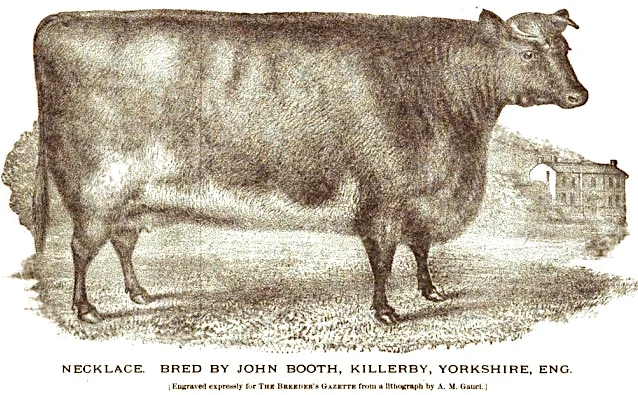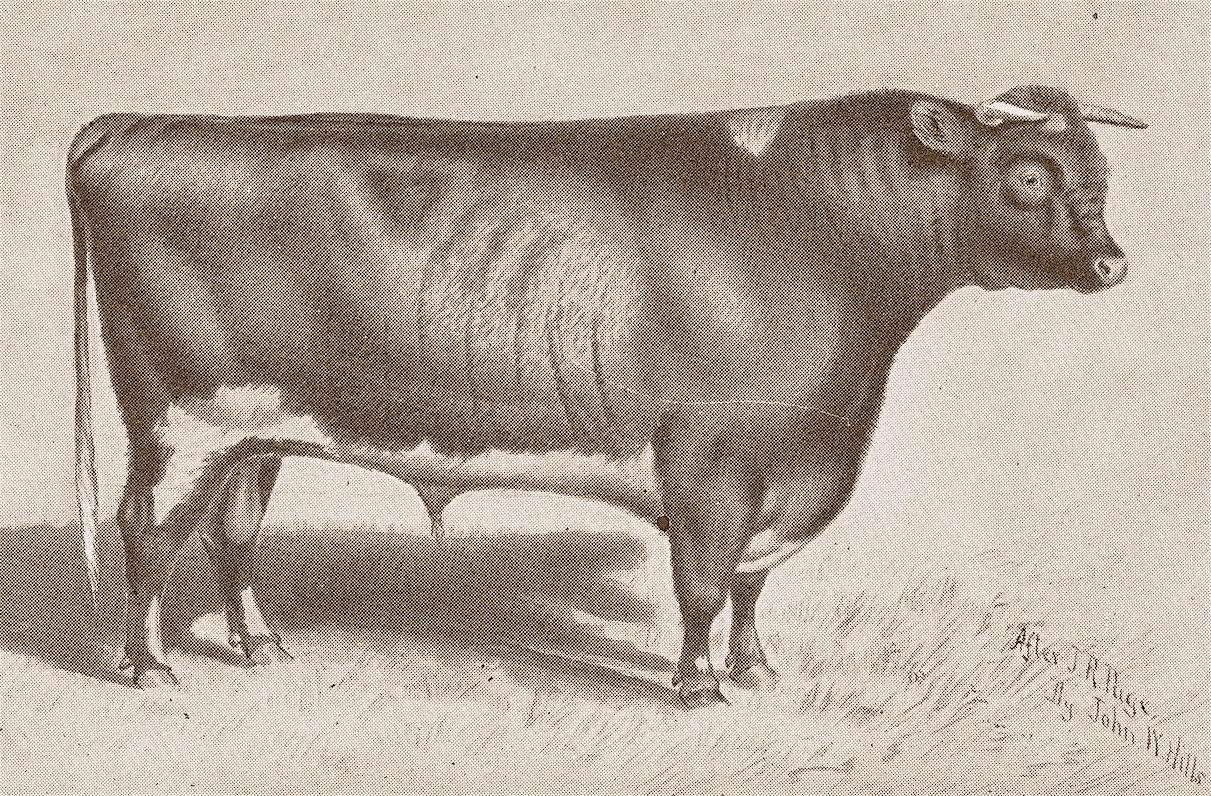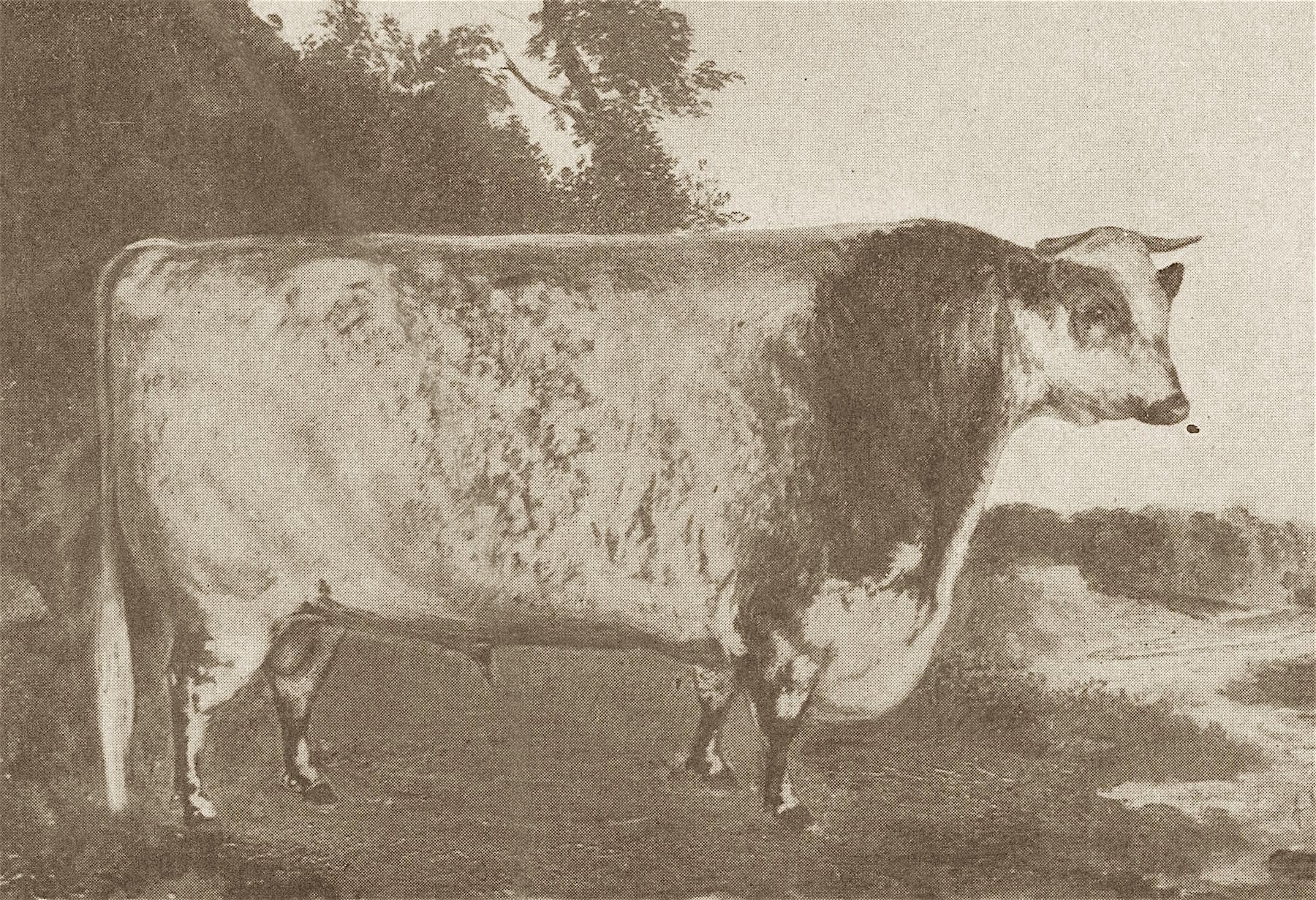Historical Shorthorns Prior to 1890
19th Century Agriculture
The 19th century was a time of rapid improvement in agriculture in both Great Britain and the United States. Farming systems changed, and food production grew along with the expanding populations. Shorthorns were one of the earliest breeds to be improved and the first to be popularized, so North America drew from Great Britain their breeding stock as well as their breeding methods. Throughout the century there were times of agricultural prosperity as well as depression and people’s reaction to them reflected these fluctuations. There were also times of fads and pedigree worship which had to be overcome by common sense and practicality. It was during this century that Shorthorns became the most widely distributed cattle breed in the world, and they took part in the expansion of the use of both meat and dairy products in everyday diets.
This section includes: Bulls: Favourite, The Durham Ox, Comet, Duke of Northumberland, Duke of Airdrie, Commander-in-Chief, Baron Booth of Lancaster, Duke of Connaught, Baron Victor, Field Marshall
Cows: The White Heifer That Travelled, Bracelet, Necklace, Mollie Millicent, & *Duchess Cows*
Note: Drawings of cattle in the 1800s were often stylized to suggest smaller legs and greater depth of body than was true for the actual animal. The color highlighting in some pedigrees shows examples of how “In and In Breeding” was used in the creation of Shorthorns. (See comments about "In and In Breeding" in the Early History paragraphs of the Breed History Page.
Favourite #(252)
Born: 1793, (Died 1809)
Bred by Charles Colling, Ketton, Durham County, England
Sire: BOLINGBROKE (86)
Dam: PHOENIX (v1 p433E)
He is referred to as “the greatest of old-time sires and a large massive bull of good constitution.” He so nearly met what the Colling Brothers view was as to what a Short-horn should be that they began to use him in a most extraordinary course of inbreeding. For years he was used indiscriminately on his own offspring, often to the third and in instances to the fifth and sixth generations. His progeny were the most celebrated Shorthorns of their day and his immediate descendants constituted a large percentage of the entire foundation stock upon which the Coates herd-book record stands. (Note the “blanks” in his pedigree realizing that most of the early information in the Coates Herd Book, first published in 1822, had to come from private herd records.)
“THE DURHAM OX”
Born: 1796
Bred by Charles Colling, Ketton, Durham County, England
Sire: FAVOURITE (252)
Dam: A COMMON BLACK & WHITE COW, (purchased at the Durham Fair for £14)
This steer sired by Favourite (252) was fed to a weight of 3024 pounds at five years which was referred to as his “greatest flesh-taking capacity when his whole carcase was covered with thick fat.” He was then prepared for public exhibition. For six years he travelled throughout the principal parts of England and Scotland in a carriage while a fee was charged to view him because “he was such a wonderful animal far exceeding what had ever been seen before.” Offers as high as $10,000 were refused for him which was strong proof of his excellence as well as his exhibition value. At the time Shorthorns were a local breed and he did much to widen their recognition throughout Great Britain.
COMET #(155)
Born: 1804 Bred by Charles Colling
Sire: FAVOURITE (252)
Dam: YOUNG PHOENIX (v1 p434E)
Sold for £1000 ($5000) in 1810, a time of great agricultural prosperity in Great Britain, as the attraction of the Ketton (Charles Colling) dispersion. He was a product of very close breeding as his pedigree indicates. “It was admitted that no bull so good had ever before been seen, and eminent breeders have since said that they never again saw his equal.”
“THE WHITE HEIFER THAT TRAVELLED” (v1 p286E)
Born: “About 1806”,
Bred by Robert Colling, Barmpton, Durham County, England
Sire: FAVOURITE (252)
Dam: FAVOURITE (252) COW (v1 p286E)
Born twin to a bull and thus a free-martin sired by Favourite (252), she also was fed up to her “greatest flesh-taking capacity” and extensively exhibited. The reputation and wider knowledge of the Collings and their cattle were obtained from these public exhibitions. Her weight at the time of her eventual slaughter was reported to be no less than 2300 lbs.
DUKE OF NORTHUMBERLAND #(1940)
Born: Oct. 15, 1835 Bred by Thomas Bates
Sire: BELVEDERE (1706)
Dam: DUCHESS 34TH (v1 p238E)
Considered to be the crowning achievement of Thomas Bates as a cattle breeder. Acknowledged as the champion bull of England in 1842. His weight at three years and eight months was 2520 pounds.
Bracelet (v5 p726E) (V6 p762E), & Necklace (v6 p275E)
Born: 1837 Bred by Mr. John Booth, Killerby, England
Sire: PRIAM (2452)
Dam: TOY (v1-3 p710E)
Necklace and Bracelet were an outstanding set of twin females that brought a great deal of attention to the Booth program. Between the two of them they garnered a total of 33 prizes at shows such as the Royal, Yorkshire and Smithfield Club. It was said that” Necklace had neater forequarters and was better filled up behind the shoulders. Bracelet had fuller, longer and more level hind quarters. Both were of remarkable individual excellence; both were wonderful show ring animals and both left progeny which made their mark.”
Duke of Airdrie (12730) (v11E) 9798 v10
Born: August 4, 1854 Bred by R.A. Alexander, Airdrie Scotland
Imported to his farm, Woodburn, Woodford Co. KY
Sire: DUKE OF GLOSTER (11382)
Dam: DUCHESS OF ATHOL
A “Bates Duchess bull, the original progenitor of the American Dukes of Airdrie and called in Kentucky ‘The Old Duke’. He had a lot of quality, long level hind quarters but the fault of prominent hips. He was not above average in size with a short, well-carried head, rather strong horns, smooth shoulders and an exceptionally straight and level top. He proved to be a wonderfully successful sire of good bulls and did more to shape the course of Shorthorn breeding in the West (Kentucky) during the twenty years following his importation than any other animal of that period.”
COMMANDER-IN-CHIEF (21451) (v16E)
Born: May 19, 1864 Bred by Richard Booth
Sire: VALASCO (15443) (v12E)
Dam: CAMPFOLLOWER (v15 p402E)
A product of the Booth breeding program from which they achieved their best results by interbreeding their own established tribes or families. He was produced near the end of the breeding careers of the Booth family.
BARON BOOTH OF LANCASTER 7535 v9
Born: February 22, 1867 Bred by G.R. Barclay, Keavil, Scotland, Imported by M.H. Cochrane, Compton, Quebec, Owned by J.H. Pickrell, Harristown, IL
Sire: BARON BOOTH (21212) (v16E)
Dam: MARY OF LANCASTER (v15 p571E)
Purchased for $1550 in 1869 by J. H. Pickrell. He was said to be “the greatest Short-horn of his day and generation on this continent.” His own show winnings and those of his get dominated at the fairs and elevated Illinois’ position as a state in the production of high class Shorthorns. His mature weight was reported to be 2600 pounds. J. H. Pickrell became the editor of the American Shorthorn Herd Book and first secretary of the American Shorthorn Association.
DUKE OF CONNAUGHT (33604)
Born: Aug. 10, 1874 Bred by Earl of Dunmore, Stirling, Scotland
Sire: DUKE OF HILLHURST (28401) (v19E)
Dam: DUCHESS 108TH (v21 p685E)
He was purchased on August 25, 1875 for £4500 ($26,904 US), the greatest price ever obtained for a bull of any bred to that time. (Roughly equivalent to $600,000+ in today's dollars.) He was of the Bates Duchess tribe. The entire sale of 39 head averaged $3829 (approx. average $85,000 today). He proved to be “one of the most successful sires of high class Shorthorns ever used in Great Britain. So great was the demand for his get because of their excellence that the buyer of the bull, Lord Fitzhardinge received in stud fees and for his calves an aggregate sum of money which more than reimbursed him for his extraordinarily high purchase price.”
BARON VICTOR 42824 (45744)
Born: November 9, 1880
Bred by Amos Cruickshank, Scotland. Owned by Col. W.A. Harris, Linwood, KS
Sire: BARMPTON 45246 (37763)
Dam: VICTORIA 58TH (v26 p393E)
Purchased for $1,100 in 1882 by Col. W.A. Harris from Kansas who became “the real leader of Scotch Shorthorn forces during the 1880s.” Baron Victor was described as “a blocky, broad ribbed, short-legged, mellow, thick-fleshed red, strong in head and horn, but standing very near to the ground.” He helped to establish the type of Shorthorns “with sound constitutions and satisfactory feeding capacity needed by the hard-working farmers of the region.”
FIELD MARSHAL 64894 (47870)
Born: Mar. 12, 1882 Bred by Amos Cruickshank
Sire: ROAN GAUNTLET 45276 (35284)
Dam: AZALEA (v25 p409E)
A product of Amos Cruickshank’s program but used in William Duthie’s Collynie herd who secured many of the top females when Cruickshank sold out. “A massive 2500-pound bull, he sired some of the most celebrated show and breeding stock ever sent out from the North of Scotland.” He was leased for three years to Queen Victoria’s Windsor herd which increased the interest in Scotch Shorthorns in England.
MOLLY MILLICENT (v34 p581E)
Born: June 11, 1884 Bred by Mr. Robert Thompson, Penrith, England
Sire: BEAU BENEDICT (42769) (V26E)
Dam: FAIR MILLICENT 2ND (v32 p593E)
Celebrated English show cow bred and exhibited by Robert Thompson, Inglewood, Penrith. Note that she is a combination of Booth and Bates (Duchess) breeding. Her picture was chosen for the Heritage Shorthorn Society logo because she typifies the dual dairy/beef qualities of Shorthorns in the late 1800’s and early 1900’s.
Duchess Cow Lineage
The 2 "Historic Duchesses” (below) sold for $40,600 & $35,000 in 1873, which is roughly comparable to $3/4 million each in today's dollars. The Duchess line was originally by Thomas Bates, and over time it became a very long maternal lineage. Extraordinary prices were paid for "Bates Duchess bred" cattle during the time of the "Duchess craze" which occurred on both sides of the Atlantic in the late 1800s--see the comments about Duke of Connaught (33604), above. Since this lineage was ultimately in short supply in Great Britain some very high prices were paid to take cattle with Duchess pedigrees back to the "motherland". There is a fascinating discussion about them and "The Sensation of '73" in Alvin H. Sanders book "Shorthorn Cattle".
Pedigrees of 8th Duchess of Geneva and 10th Duchess of Geneva
10th Duchess of Geneva v8 p321 by 2d Duke of Geneva 5562
Roan, May 16, 1867, James O. Sheldon, Geneva,
N.Y.
5th Duchess of Geneva by Grand Duke of Oxford (16184)
White, Oct. 7, 1864, James O.
Sheldon
Duchess of Geneva by 2d Grand Duke 2181 (12981)
Duchess 71st by Duke of Gloster 2763 (11382)
Roan, May 20, 1854, Morris & Becar
Duchess 66th (v11 p415E) by 4th Duke of York (10167)
Roan, Oct. 25, 1850, Earl Ducie, Gloucestershire, England
Duchess 55th (v9 p337E) by 4th Duke of Northumberland (3649)
Red, Oct. 31, 1844, Thomas Bates, Kirklevington, England
Duchess 38th (v9 p337E) by Norfolk (2377)
Roan, May 12, 1835, Thomas Bates
Duchess 33d by Belvedere (1706)
Duchess 19th by 2d Hubback (1423)
Duchess 12th by The Earl (646)
Duchess 4th by Ketton 2d (710)
Duchess 1st by Comet (155)
______by Favorite (252)
______by Daisy Bull (186)
______by Favorite (252)
______by Hubback (319)
8th Duchess of Geneva v8 p321 by 3rd Lord of Oxford 4958 (22200)
Red & white, July 28, 1866, bred by James O.
Sheldon, Geneva, N.Y.
Duchess of Geneva by 2d Grand Duke 2181 (12981)
Duchess 71st by Duke of Gloster 2763 (11382)
Roan, May 20, 1854, Morris & Becar
Duchess 66th (v11 p415E) by 4th Duke of York (10167)
Roan, Oct. 25, 1850, Earl Ducie, Gloucestershire, England
Duchess 55th (v9 p337E) by 4th Duke of Northumberland (3649)
Red, Oct. 31, 1844, Thomas Bates, Kirklevington, England
Duchess 38th (v9 p337E) by Norfolk (2377)
Roan, May 12, 1835, Thomas Bates
Duchess 33d by Belvedere (1706)
Duchess 19th by 2d Hubback (1423)
Duchess 12th by The Earl (646)
Duchess 4th by Ketton 2d (710)
Duchess 1st by Comet (155)
______by Favorite (252)
______by Daisy Bull (186)
______by Favorite (252)
______by Hubback (319)


























